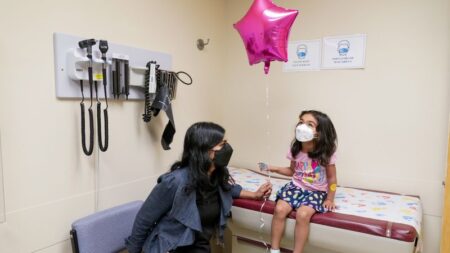A recent study conducted by the US Centers for Disease Control and Prevention (CDC) has revealed an alarming rise in the diagnosis rates of autism among American children. This upward trend has been linked primarily to improved understanding, increased awareness, and enhanced screening techniques for autism spectrum disorder (ASD). The report published on a Tuesday indicated that as of 2022, approximately 1 in every 31 children was diagnosed with autism by the age of eight, a significant increase from 1 in every 36 children reported back in 2020.
The findings illustrate notable discrepancies in autism diagnosis rates based on various demographic factors, including gender, race, and geographic location. The CDC’s report underscores that these differences may be influenced by the availability of services for early detection and diagnostic processes. For instance, boys continue to be diagnosed with autism at significantly higher rates than girls, with the 2022 data showing a 3.4-fold disparity among eight-year-olds. Despite recent improvements in identifying autism in girls, this widening gap cannot be solely accounted for by enhanced identification practices.
Race also plays a critical role in the prevalence of autism diagnoses. The latest trends indicate that Asian, Black, and Hispanic children are being diagnosed more frequently than their White counterparts. Additionally, there has been a noticeable decline in diagnoses within affluent neighborhoods compared to socially disadvantaged communities, suggesting that access to early diagnostic services may have improved for previously underserved groups. However, challenges remain, particularly in recognizing autism among children with coexisting intellectual disabilities. The report highlights that over half of Black children diagnosed with autism at age eight also had an intellectual disability, in stark contrast to fewer than a third among White children.
In the realm of public health, HHS Secretary Robert F. Kennedy Jr. has tied autism to what he describes as a “chronic disease epidemic” affecting American children. During a recent event in Indiana, he asserted that this generation of children is suffering due to rising rates of chronic illnesses and emphasized the need for urgent action. Kennedy pointed out the drastic changes in autism prevalence, likening the current diagnosis rate of 1 in every 31 children to a time in his childhood when the rate was as low as 1 in 10,000. He has also raised concerns about vaccines, despite robust evidence disputing any causal links between vaccination and autism.
Experts in the field have voiced diverse opinions regarding the rise in autism diagnosis rates. Dr. Alice Kuo, a prominent pediatrician from UCLA, identified the primary crisis as the disproportionate mortality rates observed within the autistic population. Research has shown that individuals with autism are at a significantly higher risk of early mortality compared to the general populace, indicating an urgent need for addressing health disparities rather than simply diagnosing more cases.
Dr. Andy Shih, the chief science officer at Autism Speaks, expressed that the increase in diagnoses should be perceived positively. He highlighted that it reflects improved awareness of autism and more refined diagnostic criteria, encouraging continued investment in autism support systems. The commentary from Christopher Banks, president of the Autism Society of America, echoed these sentiments, emphasizing that prevalence statistics should catalyze equity and access to necessary services rather than stoking fear or political agendas.
In the face of this rising prevalence, the CDC’s new study utilized data from 16 distinct locations participating in their Autism and Developmental Disabilities Monitoring Network, an expansion from the previous survey conducted in 2020 that sourced data from 11 sites. This recent analysis showed significant variations in autism rates based on geographical location, with California reporting a prevalence of 1 in 19 children, while Laredo, Texas, exhibited a rate of 1 in 103. This divergence underscores the need for careful consideration of local services and practices used for diagnosis.
Concluding this extensive overview, CDC researchers highlighted that ongoing monitoring of autism prevalence faces challenges, including inconsistent data quality and varying definitions of intellectual disabilities. However, they noted that approximately 60-90% of autism risk is attributed to genetic factors. This scenario emphasizes the need for sustained investment in research focused on autism, not just to uncover its causes but to support the growing number of diagnosed individuals. The continual rise in diagnosis rates serves as a clear call to action, championing the necessity for improved systems, policies, and support frameworks for those affected throughout their lifetime.
CNN’s coverage included contributions from reporters Sarah Owermohle, Meg Tirrell, and Brenda Goodman, ensuring comprehensive reporting on this critical public health issue.












